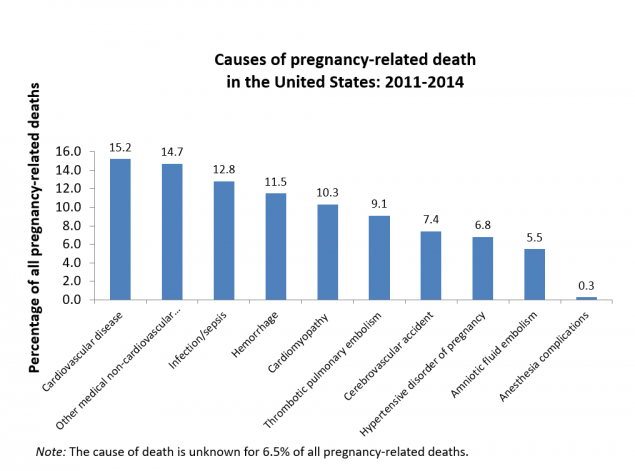Maternal Mortality: Why are women dying?
It seems like something out of a film set in ancient history – a new mother seems fine but keeps insisting that something is wrong only to be ignored by those around her. The situation worsens until she dies suddenly. Unfortunately, for all too many families in the United States, this scene is all too real. Maternal Mortality is the number of Pregnancy-related deaths per 100,000 pregnant women. As defined by the CDC – “A pregnancy-related death is defined as the death of a woman while pregnant or within 1 year of the end of a pregnancy –regardless of the outcome, duration or site of the pregnancy–from any cause related to or aggravated by the pregnancy or its management, but not from accidental or incidental causes.” In 2018 the Maternal Mortality was 20.7, placing the United States at the bottom among developed countries. This continues an upward trend from 19.9 in 2016. Missouri saw a rate of 34.6, ranking 42nd in the country. Women of color and other marginalized groups continued to be hit the hardest, even when they earned higher incomes or had a higher level of education.
Causes

Health Inequities and Maternal Mortality
Of the 7,208 deaths within a year of the end of pregnancy that occurred during 2011–2014 and were reported to CDC, 2,726 were found to be pregnancy-related. The pregnancy-related mortality ratios were 17.8, 15.9, 17.3, and 18.0 deaths per 100,000 live births in 2011, 2012, 2013, and 2014, respectively.
Considerable racial disparities in pregnancy-related mortality exist. During 2011-2014, the pregnancy-related mortality ratios were:
-
12.4 deaths per 100,000 live births for white women.
-
40.0 deaths per 100,000 live births for black women.
-
17.8 deaths per 100,000 live births for women of other races.
– https://www.cdc.gov/reproductivehealth/maternalinfanthealth/pregnancy-mortality-surveillance-system.htm
These racial inequities hit black women of all economic classes. In recent years, two cases have made international news as women who are queens in their industries both had dangerous experiences during birth. Beyonce and Serena Williams both had potentially fatal complications during the births of their children in 2017, and both reported feeling as though the medical professionals working with them just weren’t listening. For Beyonce, it was preeclampsia which led to a period of bedrest and eventually an emergency c-section while pregnant with her twins.
Serena Williams had an even scarier story. The tennis player has a history of blood clots, something which she shared with her medical team prior to her emergency c-section in the birth of her daughter. This history of blood clots showed up again in a pulmonary embolism – or blood clot in her lungs. Coughing caused by the blood clots caused her c-section incision to reopen and during the emergency surgery to fix that wound doctors found a large hematoma in her abdomen.
Luckily, in both of these cases, mother and children survived and are healthy today. Unfortunately, this isn’t always the case for women who do not have access to the same resources as wealthy international celebrities.
What Can We Do?
What can we in the Bootheel do to help prevent Maternal Mortality? One of the most crucial things is to encourage pregnant women to attend their prenatal appointments and to help them overcome barriers which may be keeping them from those appointments. When issues can be caught early they are easier to treat and have better outcomes. As providers become fewer and more spread out in the area it’s important to do what we can to make transportation easier so that women don’t have to cancel appointments because they simply can’t make it there.
Further Reading
https://www.merckformothers.com/docs/missouri_Factsheet.pdf
https://www.kansascity.com/news/business/health-care/article190436299.html
https://www.cdc.gov/reproductivehealth/maternalinfanthealth/pregnancy-mortality-surveillance-system.htm
https://health.mo.gov/data/pamr/
https://health.mo.gov/information/news/2018/maternal-mortality-122018
